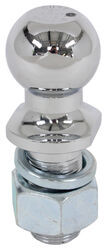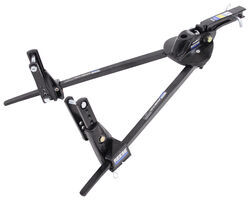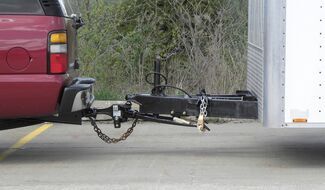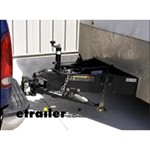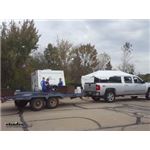
Comparing Reese Dual Cam and Reese SC Weight Distribution on Ford F150 Towing 30 Foot Travel Trailer
Question:
My tow vehicle is a 2012 Ford F150 Supercrew Ecoboost with a GVWR = 7100# and a tow capacity of 9800#. My TT is rated at: Dry Weight = 6780#, GVWR = 9500#, Hitch Weight from specs, not measured = 810#. I am looking at the Reese Dual Cam and the SC hitches. Can you recommend which system will work best in my application, and which TW rating 1000#TW vs. 1200#TW would work best? It appears that the Reese dual cam system is more complicated for installation/calibration but is a proactive system vs. a friction system of the SC. Also, can you give me pros/cons of both systems? I havent been able to measure the actual TW of the TT, and due to work schedule wont be able to before I have to place my order. We do have a scheduled camping trip coming up very soon, so a timely response would be greatly appreciated. Thanks
asked by: Larry O
Expert Reply:
When choosing a weight distribution system, it is best to begin the process knowing the fully loaded and ready to tow tongue weight. The procedure for determining this is shown in the FAQ article I have linked you to.
Since you are not able to confirm your tongue weight, please understand that anything I recommend will merely be an educated guess. I would recommend going with a 1,200 lb max capacity system to provide some cushion, since actual ready-to-roll tongue weight is not known. The weight of any gear stored in the truck bed behind the rear axle needs to be considered as tongue weight as well.
It sounds like you already have a good handle on the differences between the Reese Strait Line and Steadi-Flex systems. The Strait Line system, part # RP66084 is proactive, the detents on the spring bars normally ride in the cams, forcing the trailer to ride in a straight line behind the tow vehicle. When the tow vehicle makes a turn, the tilt of the trailer causes the bar on the outside of the turn to come off of the cam, allowing the trailer to smoothly negotiate the turn. Although the initial adjustment and set-up are indeed more involved, the Reese Strait-Line system is a bit less expensive. This is a very popular system that works very well.
The Steadi-Flex system # RP66560 derives its sway control function from friction from both the downward force of the spring bars on the trailer mounted brackets. The initial set up of this system is more simple than the dual-cam system, and there are fewer moving parts. Although the sway control portion of the system is not considered proactive, it still works very well and is highly rated by our customers.
Although the sway control offered by the Steadi-Flex system is very effective, I would give a slight performance advantage to the Reese Strait Line system.
In the end, either system would work well for you. If it were me making the decision, I would choose the Strait-Line system for its slightly more effective sway control system, which is important for longer trailers, and its slightly lower cost. If ease of set-up is important to you, you could go with the Steadi-Flex system and really not feel like you sacrificed much of anything.
Both systems include the weight distributing shanks, but the trailer ball with the correct shank diameter and length is sold separately. Use # A-90 for a 2 inch ball, or # 19286 for a 2-5/16 inch ball.

Products Referenced in This Question
2-5/16" Hitch Ball - 1-1/4" Diameter x 2-3/4" Long Shank - Chrome - 12,000 lbs
- Trailer Hitch Ball
- Trailer Hitch Ball
- Standard Ball
- Chrome-Plated Steel
- 2-5/16 Inch Diameter Ball
- 2-3/4 Inch Shank Length
- 1-1/4 Inch Diameter Shank
- 12000 lbs GTW
- Class IV
- Class V
- Draw-Tite
more information >
2" Hitch Ball - 1-1/4" Diameter x 2-5/8" Long Shank - Chrome - 10,000
- Trailer Hitch Ball
- Trailer Hitch Ball
- Standard Ball
- Chrome-Plated Steel
- 2 Inch Diameter Ball
- 2-5/8 Inch Shank Length
- 1-1/4 Inch Diameter Shank
- 10000 lbs GTW
- Class IV
- Class V
- CURT
more information >
Reese Steadi-Flex Weight Distribution System w/ Sway Control - Trunnion - 12K GTW, 1.2K TW
- Weight Distribution Hitch
- WD With Sway Control
- Some Sway
- Includes Shank
- Electric Brake Compatible
- Surge Brake Compatible
- Fits 2 Inch Hitch
- Allows Backing Up
- 1000 lbs
- 1100 lbs
- 700 lbs
- 800 lbs
- 900 lbs
- Reese
more information >
Product Page this Question was Asked From
Strait-Line Weight Distribution System w/ Sway Control - Trunnion Bar - 12,000 lbs GTW, 1,200 lbs TW
- Weight Distribution Hitch
- WD With Sway Control
- Some Sway
- Includes Shank
- Electric Brake Compatible
- Fits 2 Inch Hitch
- Allows Backing Up
- 1000 lbs
- 1100 lbs
- 700 lbs
- 800 lbs
- 900 lbs
- Reese
more information >
Featured Help Information
Instructions
Miscellaneous Media

Continue Researching
- Article: Which Sway Control Hitch is Right For Your Trailer?
- Article: 5 Things to Know About Weight Distribution Hitches
- Article: Determining Trailer Tongue Weight
- Article: 2 Steps for Finding the Right Weight Distribution Hitch Size
- Q&A: Recommended TorkLift Hitch and Extension for a 2024 Chevy Silverado 3500
- Article: How to Measure for Trailer Hitch Drop
- Article: 5 Tips to Confidently Choose Your Weight Distribution Hitch
- Q&A: Can Blue Ox SwayPro Weight Distribution be Used With Equal-i-zer Weight Distribution Shank
- Q&A: Can the TorkLift Everest Weight Distribution System Be Used w/ a SuperTruss Extension?
- Q&A: Is there a Longer Weight Distribution Shank for a B&W Continuum?
- Q&A: What Does Underslung Coupler Look Like for Picking Out B and W Continuum Weight Distribution
- Q&A: Recommended Weight Distribution System for a 6,800 lbs 2019 Lance 2465 Travel Trailer
- Article: Tire TLC: How & When to Check Your RV/Trailer Tire Pressure
- Q&A: Can Strait Line Weight Distribution be Used with Feather Lite Trailer





